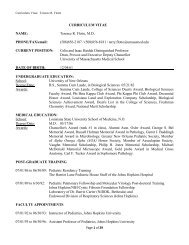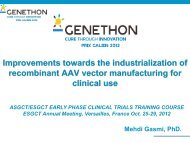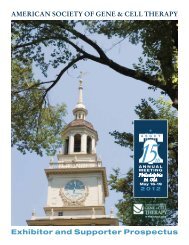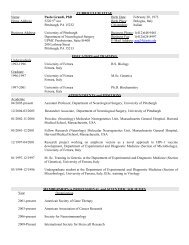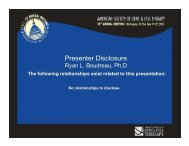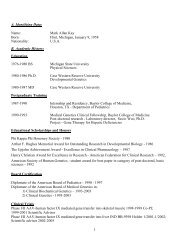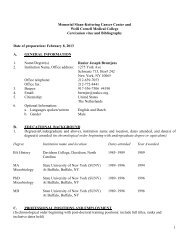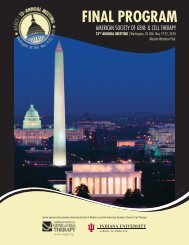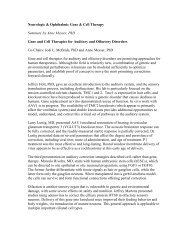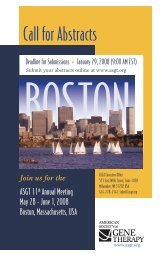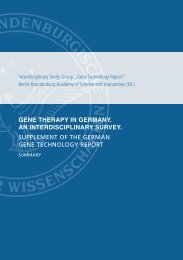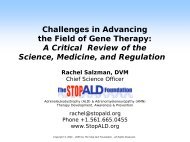Final Program - American Society of Gene & Cell Therapy
Final Program - American Society of Gene & Cell Therapy
Final Program - American Society of Gene & Cell Therapy
Create successful ePaper yourself
Turn your PDF publications into a flip-book with our unique Google optimized e-Paper software.
<strong>Program</strong> Schedule, Friday, May 17, 2013<br />
Scientific Symposium 311<br />
9:45 am - 11:45 am<br />
ROOM: BALLROOM B<br />
<strong>Cell</strong> and Tissue Engineering for Musculoskeletal Disease<br />
CO-CHAIRS: Alan J. Nixon, DVM, MS and Bing Wang, MD, PhD<br />
SPEAKERS<br />
Rita Perlingeiro, PhD<br />
From iPS cells to Skeletal Muscle Precursors: Potential for <strong>Gene</strong> Correction and Therapeutic Application<br />
A major obstacle in the application <strong>of</strong> cell-based therapies for the treatment <strong>of</strong> neuromuscular disorders is obtaining the<br />
appropriate number <strong>of</strong> stem/progenitor cells to produce effective engraftment. The use <strong>of</strong> pluripotent embryonic stem (ES) or<br />
induced pluripotent stem (iPS) cells could overcome this hurdle. We have developed a method to eficiently generate skeletal<br />
myogenic progenitors from pluripotent stem cells through Pax3 or Pax7 induction. We have applied this method to mouse ES<br />
and iPS cells, and more recently to human ES and iPS cells. In each case, Pax7-induced cells engraft extensively and promote<br />
improved contractility in transplanted dystrophic muscles (using a mouse model for Duchenne Muscular Dystrophy). In addition<br />
to generating new myoibers, the transplanted cells also seeded the muscle satellite cell compartment. Accordingly, in long-term<br />
cohorts, the frequency <strong>of</strong> human-speciic dystrophin+ ibers declined only modestly at one year post-transplant, compared to one<br />
month. Based on these indings, we are now focusing on the genetic correction <strong>of</strong> iPS cells encoding mutations in the dystrophin<br />
gene. Such studies are crucial for the future therapeutic application <strong>of</strong> iPS-derived myogenic progenitors in the autologous setting<br />
for DMD. These more recent studies will also be discussed.<br />
Rocky S. Tuan, PhD<br />
Regenerative Applications <strong>of</strong> Adult Stem <strong>Cell</strong>s<br />
Farshid Guilak, PhD<br />
Engineering Functional Tissue Replacements to Treat Osteoarthritis<br />
Osteoarthritis is painful and debilitating joint disease that is characterized by pain and degenerative changes in the articular<br />
cartilage and other joint tissues. While a number <strong>of</strong> techniques have been developed over the years for the treatment <strong>of</strong> small<br />
cartilage defects, there have been few attempts at tissue-engineered therapies for end-stage osteoarthritis. Some <strong>of</strong> the major<br />
considerations for this approach include the identiication and characterization <strong>of</strong> an abundant and accessible cell source as well as<br />
the design <strong>of</strong> biologically and mechanically functional scaffolds that can withstand joint loading. Here we describe the engineering<br />
<strong>of</strong> large, anatomically-shaped cartilage constructs using different stem cell sources (adipose stem cells, mesenchymal stem cells,<br />
or induced pluripotent stem cells), combined with mechanically functional cell-instructive scaffolds based on three-dimensional<br />
weaving <strong>of</strong> biocompatible ibers. As each iber is selected individually, this textile processing technique allows site-speciic<br />
functionalization <strong>of</strong> proteins or virus to facilitate the formation <strong>of</strong> complex inhomogenous tissues from a single cell source.<br />
Brian Johnstone, PhD<br />
Stem <strong>Cell</strong>s for Cartilage Repair<br />
Scientific Symposium 312<br />
9:45 am - 11:45 am<br />
ROOM: 150 DEFG<br />
<strong>Gene</strong> <strong>Therapy</strong> and Regenerative Medicine for Ocular and Metabolic Diseases<br />
CO-CHAIRS: Alberto Auricchio, MD and Thierry C. VandenDriessche, PhD<br />
SPEAKERS<br />
Friday, May 17, 2013<br />
Ian Constable, AO<br />
Development <strong>of</strong> AAV-sFLT-1 for the Treatment <strong>of</strong> Wet Age-related Macular Degeneration<br />
The eye is an attractive organ in which to develop gene therapy. There is relative ease <strong>of</strong> access, a benign immunological response<br />
and the availability <strong>of</strong> high resolution non-invasive structural and functional tests. The safety and possible eficacy <strong>of</strong> Adenoassociated<br />
Viral (AAV) gene therapy is now well established in young humans with RPE-65 defective retinal blindness. We have<br />
adopted similar techniques to treat wet macular degeneration by subretinal injection <strong>of</strong> AAV-sFLT-1 to up-regulate production <strong>of</strong><br />
sFLT-1, a competitive analogue <strong>of</strong> the soluble Vascular Endothelial Growth Factor receptor.<br />
<strong>Final</strong> <strong>Program</strong> SALT LAKE CITY, UTAH May 15–18, 2013<br />
59



